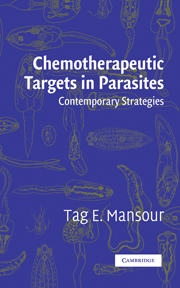Book contents
- Frontmatter
- Contents
- Preface
- Acknowledgments
- 1 The Search for Antiparasitic Agents
- 2 Biophysical, Genomic, and Proteomic Analysis of Drug Targets
- 3 Energy Metabolism in Parasitic Helminths: Targets for Antiparasitic Agents
- 4 Antimalarial Agents and Their Targets
- 5 Antitrypanosomal and Antileishmanial Targets
- 6 Targets in Amitochondrial Protists
- 7 Neuromuscular Structures and Microtubules as Targets
- 8 Targets in the Tegument of Flatworms
- Epilogue
- Index
- References
6 - Targets in Amitochondrial Protists
Published online by Cambridge University Press: 11 August 2009
- Frontmatter
- Contents
- Preface
- Acknowledgments
- 1 The Search for Antiparasitic Agents
- 2 Biophysical, Genomic, and Proteomic Analysis of Drug Targets
- 3 Energy Metabolism in Parasitic Helminths: Targets for Antiparasitic Agents
- 4 Antimalarial Agents and Their Targets
- 5 Antitrypanosomal and Antileishmanial Targets
- 6 Targets in Amitochondrial Protists
- 7 Neuromuscular Structures and Microtubules as Targets
- 8 Targets in the Tegument of Flatworms
- Epilogue
- Index
- References
Summary
Biology of Amitochondrial Protists
The parasitic protozoa discussed in this chapter are grouped together on the basis of the nature of their fermentative energy metabolism. In addition to having no mitochondria, they undergo no cytochrome-mediated electron transport and no oxidative phosphorylation processes. These organisms, which do not live intracellularly, have metabolically adapted to survive under strictly anaerobic conditions or under low levels of oxygen tension in the lumen of the gut or in the vagina of their hosts. They are represented here by Entamoeba histolytica, Giardia intestinalis, and Trichomonas vaginalis. All these parasites are aerotolerant and take up O2 that is present in their natural habitat. The O2 does not appear to be involved in energy production but is used as a means of detoxifying potentially noxious or toxic materials in their environment (Coombs & Muller, 1995). Looking at them from the evolutionary point of view they appear to have evolved at a time when life was predominantly anaerobic and mitochondria were unknown. Because of this and other metabolic differences there is a view that amitochondrial eukaryotes have separated early from the main trunk of eukaryotic evolution (Muller, 1988). However, a report by Mertens et al. (1998) on the marked diversity of pyrophosphate-dependent PFK sequences of some protists makes this conclusion less certain. These organisms have pyruvate:ferredoxin oxidoreductases that function as electron transport proteins. Others, especially Trichomonas spp., have developed new organelles called hydrogenosomes, which are compartments for energy metabolism.
- Type
- Chapter
- Information
- Chemotherapeutic Targets in ParasitesContemporary Strategies, pp. 129 - 155Publisher: Cambridge University PressPrint publication year: 2002



